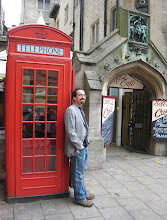The town of Meissen, outside of Dresden, has been the porcelain capital of Europe since 1710 when porcelain technology was discovered for the first time outside of China.
The historic town itself (founded in 1150) still has palaces, cathedrals, fortresses, and so forth. It was somehow completely spared during the second world war, but it was almost destroyed by neglect during the DDR era (“The government that creates ruins without weapons”). It is worth the visit if you happen to be in the area.
Despite the long history of the town, its greatest fame is its porcelain. About half the physicists attending QHSYST-2010 in Dresden last week made an excursion to tour the town and the famous porcelain factory. I think the tour guides were a bit taken aback that we physicists were there taking detailed notes (or at least I was taking notes) about the details of the porcelain process (being that most physicists don’t really care so much about dinner settings and the like).
So here is the rough process: Feldspar, Quartz, Kaolin, makes the base clay-like material. Underglaze dyes are mainly Cobalt Blue and Chrome Oxide. There are three bakings, 950 degrees C, 1100-1150 degrees C, 950 degrees C. The overglaze painting is after the middle bake. One obtains a 16% reduction in size after the hot baking. While the tour guide was very nice (a third generation porcelain-ite) very quickly we reached questions that the she could not answer and probably had never been asked before. I hope we (I) did not annoy her too much.
The porcelain products are all hand decorated – and hand crafted (if you allow molds within the definition of “hand crafted”). This makes them rather expensive. For example, this 200 piece dinner service (without the glassware or silver) will set you back 30,000 euro (36,000$) more or less.

A hand painted porcelain chandelier was 80,000 euro. Fortunately, the chandelier is hideously ugly and no one in their right mind should want one even if it were free. In fact, this is more or less my opinion of most of their products. Impressive art work, perhaps, but truly awful.
Now, you might think that my distaste for porcelain is just because I am an uncultured nerd... but in fact, I’m not the only one who thinks this. The famous german author Goethe, visited Meissen in 1813 and thought more or less the same. The following quote was translated for me by a nice tour guide:
“It is funny and almost incredible that there is nothing that you would want to have in your household. This is the oddest exhibition of everything that does not please and can never please again”
I fear the tour guide gave me this quote (without a hint of irony) thinking that it only showed how wrong Goethe was. There is a reason that Goethe is viewed as one of the true geniuses of his age.

No comments:
Post a Comment